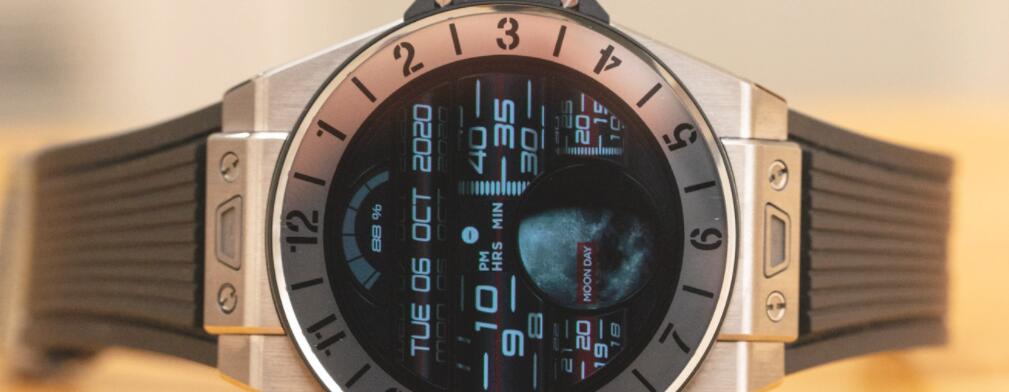It was only two years ago, as part of its sponsorship of the most recent soccer World Cup in Russia, that Hublot entered the smartwatch fray. And it did so in a high-profile way that, in reality, included a fairly limited production of 2018 pieces. The Big Bang Referee was designed to be worn by referees and fans during the competition. At $5,200, it was the least expensive Hublot that one could buy, while also being among the most expensive smartwatches out there. Clocking in at 49mm in diameter with a thickness that eclipsed 13mm, it was also a seriously big watch.
Now we see an evolution of the Hublot smartwatch and a reaffirmation of the company’s commitment to the digital wearable category in the form of the new Hublot Big Bang e. With a diameter of just 42mm and a thickness of 12.8mm, it brings a significantly smaller form factor to the table. The case is very much that of a Big Bang. It has the sandwich style-construction that Hublot created for this line back in 2005, comprising some 42 components, 27 of which are for the K module, the cage housing the digital components at the heart of the watch. It also features a real sapphire crystal and the Hublot One Click strap attachment system, which makes changing out a host of colorful straps easy to do without a tool.
The watch comes close on the heels of the most recent version of TAG Heuer’s Connected Watch, which arrived in March. And the press release for today’s announcement does mention that the Hublot Big Bang e was developed with other brands in the LVMH Group and adapted and perfected to meet Hublot’s requirements.
Like the Big Bang Referee from a couple of years ago, the new Big Bang e runs on Google’s Wear OS, which means that users can utilize a host of apps found in the Google Play Store as well as the Google Pay and the Google Assistant features. Whereas the Big Bang Referee ran on an Intel processor, this one has the Qualcomm Snapdragon Wear 3100 at its core, the same processor used to power the most recent TAG Heuer Connected 45mm. Whether you use an Android device or iOS, the Hublot Big Bang e is compatible with your phone.
At launch, the Big Bang e is available in two versions, titanium and black ceramic, and will feature exclusive interpretations of traditional watch complications. For example, there is a perpetual calendar with a precise moon phase display, and there is also a GMT complication the depicts the planet earth with a quite realistic graphic. The first edition of the Big Bang e is launching with a series of eight dials created with the artist Marc Ferrero. Every three hours over a 24-hour period, the dial changes color, and each full hour is punctuated by an animation that lasts five seconds. Above and below, you can see some of Ferrero’s colorful designs. More dials will gradually be unveiled courtesy of Hublot ambassadors and friends of the brand in the contemporary art world.
Purely anecdotally, Hublot is a watch brand that I’ve seen fairly often on the wrists of people out and about in New York. The young father of a family of European tourists, for example, or a stylishly dressed young woman on the subway. The company’s following is significant, and it’s apparent if you’re paying attention to people’s wrists.
And of course, Hublot is a fairly new brand, certainly by the standard of luxury Swiss watchmakers (the company was founded by Carlo Crocco in 1980). It subscribes to a design aesthetic that is thoroughly modern and seems to target a younger audience. Add to that its early penchant for seeking sponsorships outside the bounds of what were once considered the traditional playgrounds of golf, tennis, and motorsport, and you start to see that Hublot is a luxury marque that has been very intentionally, and extremely successfully, cast as a different kind of Swiss watchmaker. All of this is to say that I’m not the least bit surprised by Hublot’s decision to make a smartwatch.
I’ve yet to go hands-on with the Hublot Big Bang e, but from the looks of it, this watch seems to be made to the same standard as a conventional automatic Big Bang. And with that build, there does come a steep price tag, certainly by the standard of other smartwatches like the Apple Watch. The titanium version will cost $5,200, and the black ceramic version will cost even more, at $5,800. There are no doubt other watches out there that pack similar electronic specs for less money – for example the TAG Heuer Connected, which uses the same processor – but then, those watches aren’t Hublot Big Bangs.
The watch will launch online for sale on the Hublot website and will be available exclusively to the company’s Hublotista collector club until June 15. (It will also be available on the WeChat network in China.) On June 15, it will be available in Hublot boutiques and through the company’s traditional distribution network, as well as online. In addition to the Hublot Big Bang e, Hublot will make 80+ references available for purchase on its new e-commerce platform. That catalog will go live on July 1.
